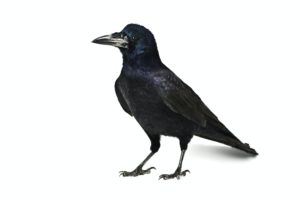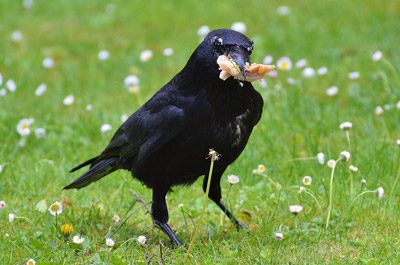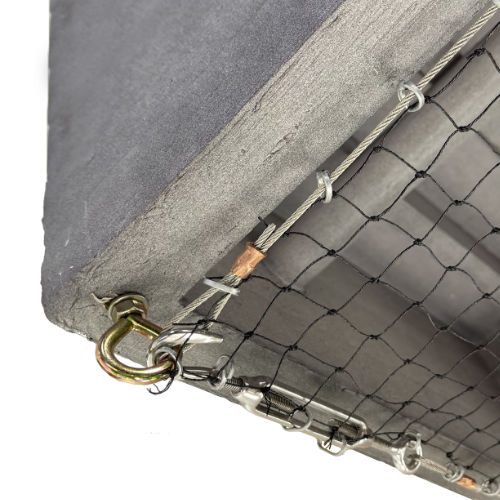Raven Bird Control
How to Keep Ravens Away from Buildings, Garages, Houses, Farms, and More
Got a Raven Problem?

Ravens are a problem for all types of properties, from parking lots to agricultural fields, to suburban homes and even buildings in urban areas. Flocks of ravens create a lot of noise, leave messy droppings that can spread disease, strew garbage around, and cause property damage to buildings and landscaping. Ravens are also major agricultural pests that damage crops, particularly corn, peanuts, sunflowers, pecans, and various fruits. In some instances they prey on livestock, such as newborn lambs or goats.
Need help identifying ravens?
How to Keep Ravens Away
A good first step to deter ravens is to remove potential food sources. Secure trash cans, remove bird feeders, and bring pet food containers inside. If that tactic doesn’t work, you may need to take additional steps to get your raven problem under control.
With the right raven control products, you can solve your raven problem for good, the first time. At Bird Barrier, we’re here to help you find exactly what you need for your situation—whether it’s for a commercial building or your home. We offer expert support from product selection advice and our installation videos to our top-of-the-line customer service.
Ravens are intelligent and determined birds with good memories and the ability to use tools. Ravens have also been known to remember the faces of their enemies and hold grudges. To truly get rid of ravens, and keep them away fo
r good, you’ve got to outsmart them. The most effective approaches to raven control are:
Exclusion bird netting like StealthNet
Ledge deterrents like Bird-Shock or Dura-Spike
Audio, Visual, and Taste Deterrents
Recommended Raven Control Products
Bird-Shock® Flex-Track™
A low-profile, electrified, ledge deterrent system that is effective against all species of birds.
Dura-Spike™
Economical bird spike made from 100% Stainless Steel. Perfect for Pigeons or larger birds.
StealthNet®
The strongest, most versatile bird exclusion system. StealthNet bird netting denies birds access to any architecture.
BirdSlide™
All bird species simply can’t get a grip and slide right off the ledge. Inverted, it prevents swallow nests.
Scaring Ravens Away: Audio and Visual Deterrents
Visual and audio deterrents are a form of harassment techniques designed make scare ravens and make them uncomfortable enough to migrate to another area. Ravens are much more likely to vacate a new roost site rather than an established one so it is important to act quickly after they arrive.
It is possible to drive away large flocks of ravens and other blackbirds with audio and visual scare devices such as the Bird Gard unit combined with visual scare devices like Scare Eye Balloons, Octopus, and Flash Tape reflective tape.
To maximize effectiveness, hang visual products in trees before commencing a noise campaign.
Bird Netting to Keep Ravens Away from Buildings and Gardens
For small gardens and orchards, four-inch or smaller flexible mesh bird netting will keep ravens out. For other structures and buildings, our StealthNet® Bird Netting can be used to deter ravens from any enclosed or semi-enclosed area. StealthNet Bird Netting is available in three mesh sizes, all of which will deter ravens: 3/4,” 1-1/8″, and 2″.
How to Best Solve a Raven Problem
To determine how to best solve your particular raven problem, we must first know the answer to two questions:
1. What is the bird pressure?
Heavy: Ravens are nesting and extremely committed to the site.
Medium: Ravens are eating nearby, really like this site.
Light: Ravens are hanging out at the site from time to time, but are not committed.
 2. What structures are the ravens landing on?
2. What structures are the ravens landing on?
Roof peak
Trees
Narrow ledge
Wide ledge
Pipe
Flat surface
Signs
Protected nook
Underside of loading dock roof, on pipes and beams
Raven Deterrents for Each Type of Structure and Bird Pressure
Roof PeakMedium Pressure: Bird-Shock Flex-Track Medium Pressure: Bird Spikes » Bird-Flite or Dura-Spike Light Pressure: Bird Barrier Optical Gel | TreesAll Pressures: Tree-Shock All Pressures: Optical Gel |
Narrow Ledge (less than 6 in.)Heavy Pressure: BirdSlide Heavy Pressure: Bird-Shock Flex-Track Medium or Light Pressure: Bird Barrier Optical Gel Medium or Light Pressure: Bird Spikes » Bird-Flite or Dura-Spike | Wide Ledge (more than 6 in.)Heavy Pressure: StealthNet Heavy Pressure: Bird-Shock Flex-Track Heavy Pressure: BirdSlide Medium or Light Pressure: Bird Barrier Optical Gel Medium or Light Pressure: Bird Spikes » Bird-Flite or Dura-Spike |
PipeAll Pressures: TowerGuard All Pressures: Birdwire with Railing Clamps All Pressures: Bird Spikes » Bird-Flite or Dura-Spike | Flat SurfaceLarge Area – Medium or Light Pressure: Daddi Long Legs Large Area – Medium or Light Pressure: Eagle Eye Large Area – Medium or Light Pressure: StealthNet (over rooftop) Smaller Area – Medium or Light Pressure: Bird Barrier Optical Gel |
Billboards and SignsHeavy Pressure: StealthNet Medium or Light Pressure: Bird Barrier Optical Gel Medium or Light Pressure: Bird-Shock Flex-Track | Protected NookAll Pressures: StealthNet |
The underside of Loading Dock, on Pipes and BeamsAll Pressures: StealthNet Medium to Light pressure: Bird Barrier Optical Gel |
|
Bird Coil, Bird Wire, and Bird Shock Solutions for Ravens
Physical deterrents are the best way to keep ravens away. Bird Barrier offers several solutions to repel ravens. The best solution is complete exclusion with a 2″ mesh StealthNet. Many ledge problems can be solved by using products such as Bird-Coil, Birdwire, Bird-Flite and Dura-Spike spikes, or Bird-Shock electrical track.
Ravens can be kept off building ledges using 5″ Bird-Coil, Birdwire, Dura-Spike bird spikes, or Bird-Shock Flex-Track. Two-inch mesh StealthNet will exclude ravens completely from most areas.
How to Use Raven Control Products
Once you have determined which raven pest control products are right for your situation, watch some of our bird deterrent installation videos to assist you in learning how to use these products for maximum effectiveness.
If you need additional assistance deciding on which raven pest control products to install, we can offer guidance in the selection process and tips on how to use our raven deterrents. Larger facilities in particular often have specific needs when it comes to raven prevention or removal. Bird Barrier’s expert staff is here to help answer your questions. We can also refer you to an experienced installer in your area who can help you with raven control. Give us a call or email to learn more about our raven products and determine which control solution is right for the job. We’ll provide customized support on how to plan, order, and install any bird control system we offer.
Installers, we’ve got special hands-on bird control training options available for you.
What About Killing or Trapping Ravens?
Local laws that regulate the hunting, killing, or trapping of ravens vary from state to state. Nationally, ravens are protected under the Migratory Bird Treaty Act, which is enforced by the U.S. Fish and Wildlife Service. However, under federal regulations, ravens can be killed without a hunting license or permit when caught threatening or damaging trees, agricultural crops, livestock, or wildlife.
Lethal means of control can also be taken legally when ravens are concentrated in roosts so large that they constitute a nuisance or pose a health and sanitation hazard. However, it should be noted that shooting is not generally considered to be an effective way to manage raven populations. Also, if you are considering lethal means, keep in mind that ravens are social birds and the flock is in constant communication, which can make hunting and trapping very difficult.
Effective bird deterrents and repellents are not only much more humane, they are also usually the best solution, without negative environmental effects, dead birds to clean up, or public relations problems.
Raven Identification and Behavior

Getting to know more about ravens can help you better understand and effectively solve your raven problem.
Identifying Ravens
There are three main species of crows found in the United States, the large American crow, found all across North America, the smaller Fish crow found in the Southeast, and Northwestern crow, which is generally only found on the Pacific Coast from northwestern Washington up through southern Alaska.
The American (or Common) crow is coal black from bill to the tip of the wing and claws with a metallic violet gloss on body and a blue-violet or green-blue gloss on wings. Adults have black eyes while juveniles have blue eyes. It grows to approximately 17 to 20 inches long with a strong, stout build and a compressed bill.
The Fishing crow and Northwestern crow are smaller, darker versions of the American crow. It is incredibly difficult to tell species of crow apart visually.
Info on Habitat, Diet, Nesting, and Breeding Patterns
HabitatRavens thrive in a wide variety of habitats though they prefer to be near farms, fields, and grassland for foraging, and woodlands and forest edges for roosting and breeding. They have adapted quickly to suburban and urban environments, roosting in city parks as well as on billboards, power lines, telephone poles and other man-made structures. | DietsAll ravens are omnivores. They will eat pretty much anything they can find, including garbage, carrion, insects, seeds, grain, berries, fruit, spiders, snails, earthworms, frogs, small snakes, mice, shellfish, and even the eggs and young of other bird species. They’ve even been known, in rare cases, to hunt the young of other species, such as newborn lambs or goats. Ravens are opportunistic and always on the lookout for new food sources. They will scavenge, steal, and hunt anywhere they find food. They feed mostly on the ground, which is why you might see unsecured trash scattered around on a property near raven roosting spots. Though they do provide some beneficial insect hunting on farms, ravens often cause agricultural damage by eating newly planted seed or vulnerable early crops, especially corn. They can also cause significant damage to tender fruits and vegetables. |
NestingRavens are committed nest builders. Ravens typically build nest sites in the forks of tree branches or large shrubs between ten and seventy feet above ground. They rarely build nests on building ledges. Raven nests look like large baskets made of sticks, twigs, and mud with shredded bark, grass, feathers, or other soft material as liner. | Breeding PatternsRavens have one or two broods a year, averaging four to seven eggs per brood. Incubation takes eighteen days with a four- to five-week fledgling period before the young leave the nest. The eggs range from pale bluish-green to olive green or greenish-brown with splotches of brown and olive-gray. |
Migratory PatternsNorthern ravens will fly thousands of miles south during the winter, while southern birds stay put year round. | Flocking BehaviorOne notable characteristic about ravens is their flocking behavior. In fall and winter, they will move to better feeding areas where they will coalesce into massive feeding flocks. These feeding flocks in turn, join up with other flocks at night to form enormous communal roosts numbering from a couple thousand to tens of thousands. |






